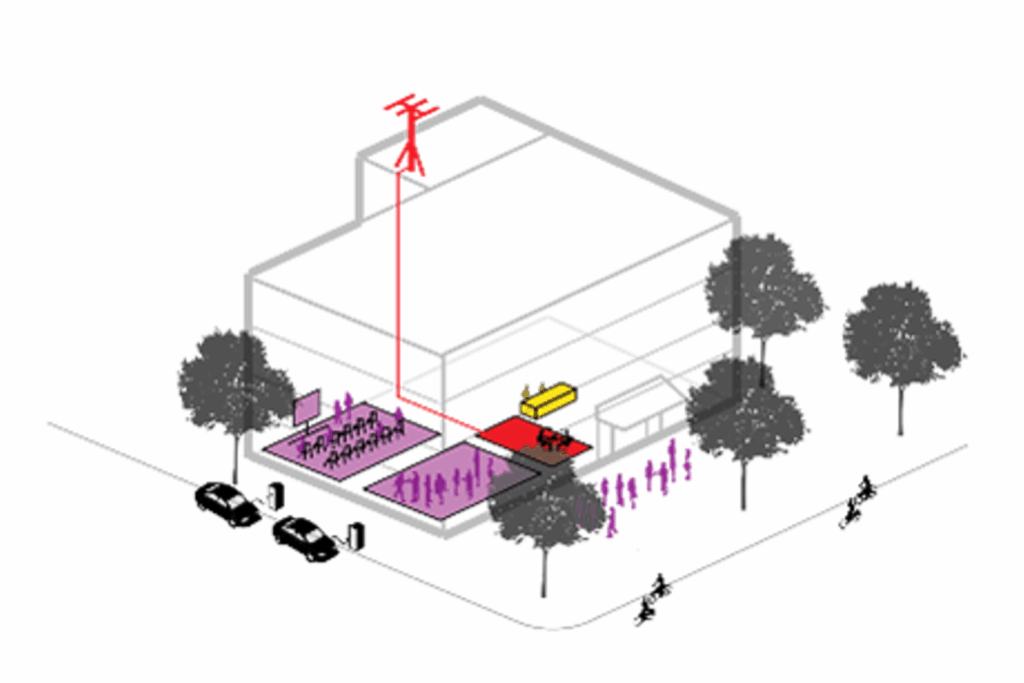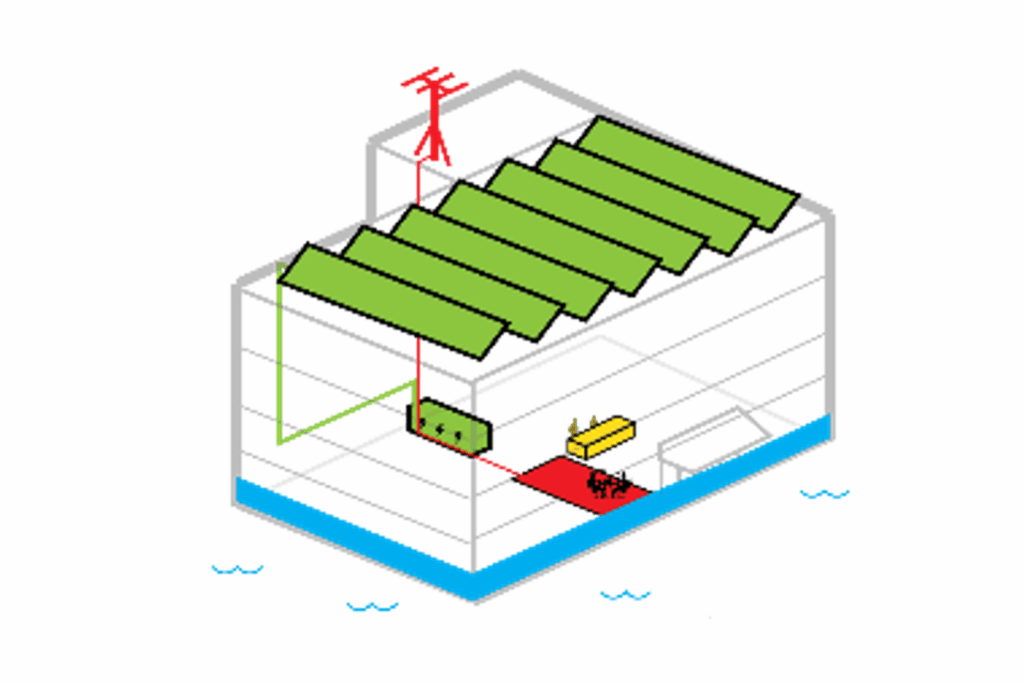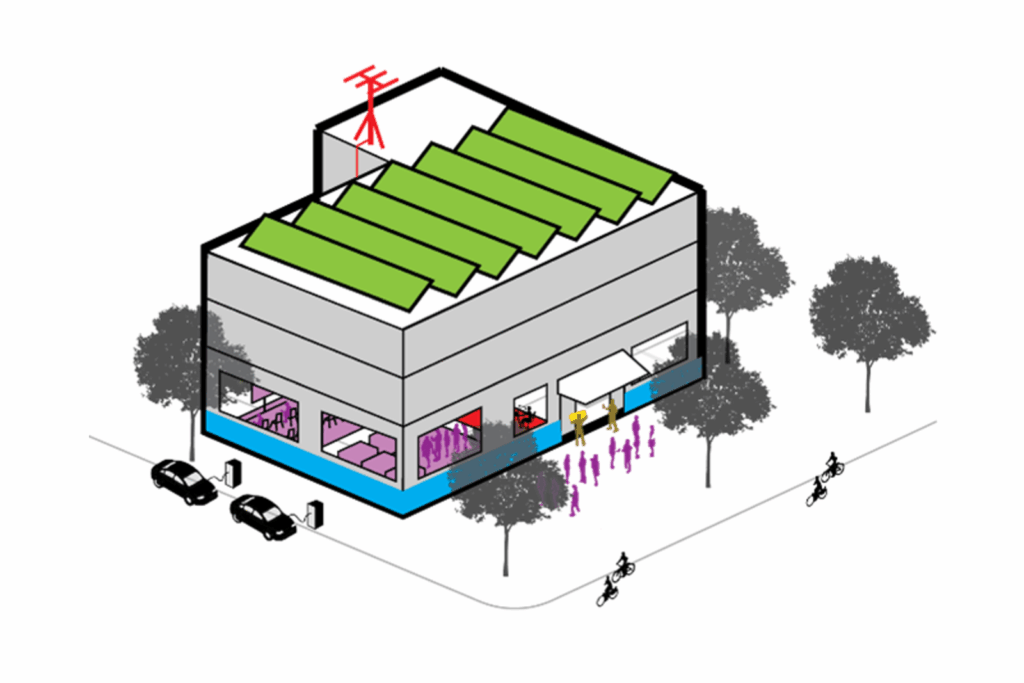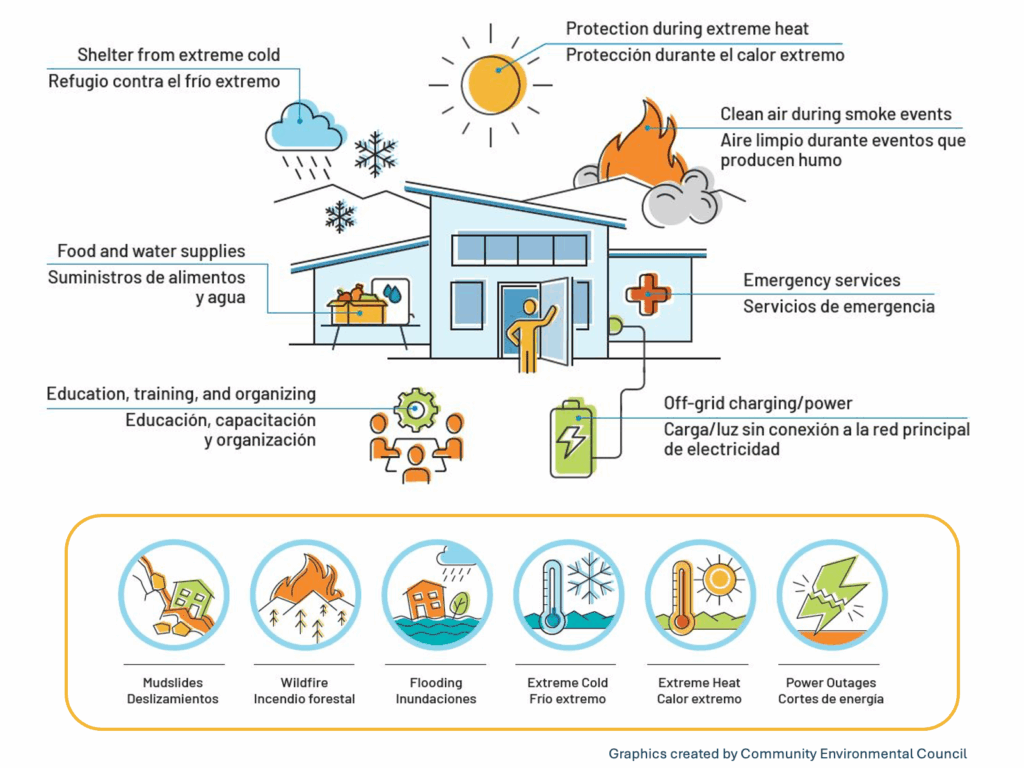Community Resilience Hubs are trusted, community-serving spaces–like schools, community centers, churches, and libraries–that provide services and resources before, during, and after disasters to support the surrounding community.
While activated during disasters for emergency response, Community Resilience Hubs also serve an important role year-round, offering programs, services, and spaces that contribute to everyday well-being and social connection. They are intentionally designed to meet the unique needs of their community, typically shaped and led directly by the communities they serve, evolving over time to address local priorities, build trust, and strengthen resilience. These Hubs often focus on advancing equity by prioritizing support for those most at risk, ensuring resources are accessible and culturally relevant.
Community Resilience Hubs may be referred to as community resilience centers, climate resilience hubs, or another similar name, and different definitions are used to describe what a Hub is and does. While terminology and definitions may vary, the core concept remains the same: community-serving spaces that bring people together, provide essential services, and support community resilience and well-being.
What is the difference between a Community Resilience Hub and an Emergency Shelter?
A Community Resilience Hub is designed to serve the community year round and provide benefits beyond momentary disaster relief whereas an emergency shelter is a short-term refuge activated during a disaster. A Community Resilience Hub can be an emergency shelter but not all emergency shelters are Community Resilience Hubs.
Here’s a more detailed look at the differences:
Community Resilience Hub
Emergency Shelter
PURPOSE
A proactive, long-term facility designed to support community preparedness, strengthen resilience, and provide ongoing services for communities.
A reactive, short-term refuge activated during disasters to ensure immediate safety and survival.
PRIMARY FUNCTIONS
- Serves as a community gathering place for education, training, and resource sharing.
- Provides year-round services, such as disaster preparedness workshops, job training, and sustainability programs.
- Provides temporary shelter for displaced individuals during disasters, such as floods, wildfires, or earthquakes.
- Offers basic necessities such as food, water, and first aid.
INFRASTRUCTURE
- Often equipped with renewable energy systems (e.g., solar panels) and backup power for continuous operation.
- Typically set up in schools, gyms, or other large spaces and may rely on temporary infrastructure.
INTENDED IMPACT
- Supports long-term resilience by strengthening community networks, building local capacity, and addressing systemic vulnerabilities before disasters strike.
- Offers immediate safety, basic necessities, and short-term refuge during and directly after a disaster.
What are the different modes of Community Resilience Hubs?
Community Resilience Hubs operate in three key modes: Normal, Disruption, and Recovery. These modes reflect the different phases of a community’s experience before, during, and after a disaster or crisis. While Hubs operate in a Normal or Steady State mode 99% of the time, they are designed to quickly shift into Disruption and Recovery modes when emergencies occur. Each mode is tailored to meet the evolving needs of the specific community each Hub serves.
Normal

Also known as “Steady State” or “Blue Skies”, Community Resilience Hubs operate in this mode the vast majority of the time. In this mode, Hubs serve as a central space for developing and implementing strategies that address the root causes of community vulnerability and promote long-term well-being. Hubs also support disaster preparedness by sharing vital information with residents and partnering with trusted community leaders to strengthen relationships and build social cohesion before a disruption occurs.
Disruption

In the event of an emergency or disaster, Community Resilience Hubs shift into response mode, providing a trusted and accessible location for community members to gather, assess needs, and access critical resources. Hubs can facilitate real-time information sharing, offer immediate support services, and coordinate with local partners to deliver aid where it’s most needed. Grounded in community relationships, Hubs help ensure response efforts are inclusive, culturally relevant, and responsive to local priorities.
Recovery

Following a disruption, Community Resilience Hubs support the shift from immediate response to long-term recovery by serving as a central space for information sharing, service coordination, and community-led problem solving. They can host recovery organizations, volunteers, and trusted leaders who work together to assess evolving needs and distribute resources equitably. Through ongoing engagement, Hubs help accelerate recovery and strengthen local capacity for future disruptions.
This approach is informed by the District of Colombia’s Department of Energy & Environment and the Urban Sustainability Directors Network.
What are the foundational elements of a Community Resilience Hub?
Community Resilience Hubs are built around five interconnected Foundational Areas that guide their design, development, and operations. These areas ensure each Hub reflects the needs and strengths of the community it serves, while remaining flexible and responsive across all three modes of operation. Overlooking any of these areas, such as focusing solely on solar power, risks prioritizing hazards over people and missing critical elements that support daily well-being and long-term adaptive capacity. A holistic approach is essential. Whether building resilience in calm times, coordinating an emergency response, or supporting an equitable recovery, the Foundational Areas provide the structure that enables Hubs to function effectively and adaptively through every phase of community resilience.
Foundational Area
Normal
Disruption
Recovery
1. PROGRAMS & SERVICES
Offering additional services and programs that build relationships, promote community preparedness, and improve residents’ safety, health, and well-being.
Offer ongoing programs that promote preparedness, social connection, economic opportunity, and community trust.
Provide essential services such as refrigeration, device charging, resource access, and medical or hygiene supplies.
Serve as a hub for long-term recovery support, including service navigation, mutual aid coordination, and community-driven healing efforts.
2. COMMUNICATIONS
Ensuring the ability to communicate within and outside the service area year-around and especially during disruptions and throughout recovery.
Consistently disseminate preparedness messaging, local news, and community updates through trusted and accessible platforms to build presence and trust.
Coordinate with government partners and trusted community channels to facilitate real-time emergency alerts, two-way communications, and coordination of response efforts.
Facilitate ongoing information sharing about recovery resources, events, and opportunities for community input and collaboration to support recovery efforts.
3. RESILIENT DESIGN, BUILDING & LANDSCAPES
Strengthening the resilience of the facility to ensure that it meets operational goals in all conditions.
Maintain and improve structures and landscapes to support everyday use, accessibility, and climate resilience.
Ensure buildings can withstand extreme weather to provide safe shelter and facilities can accommodate peak demand.
Include necessary spaces to meet new recovery programming and planning, in addition to normal activities.
4. POWER
Providing reliable backup power to maintain critical functions during a disaster while also improving the cost-effectiveness and sustainability of operations in all three operating modes.
Support clean and efficient energy use to power daily activities and services. Solar and battery storage reduces utility costs, reduces emissions, and may provide energy grid support.
Deliver backup or microgrid power to maintain essential services like lighting, refrigeration, communications, and medical equipment.
Continue providing backup power in the event of prolonged community power outages. Reconnect to the grid to resume normal power operations.
5. OPERATIONS
Establishing an effective governance model ensures personnel and processes are in place to operate the facility, smoothly and responsively across all modes of operation.
Oversee day-to-day operations, staffing, and community partnerships to successfully deliver programs and maintain readiness and service quality.
Coordinate with government partners to activate emergency protocols, coordinate relief efforts, distribute emergency supplies, and ensure sufficient personnel (augmented by volunteers).
Support recovery planning, volunteer coordination, and adaptive management to assist community rebuilding and resilience. Prepare for a second wave of disruption or support a return to steady state.

